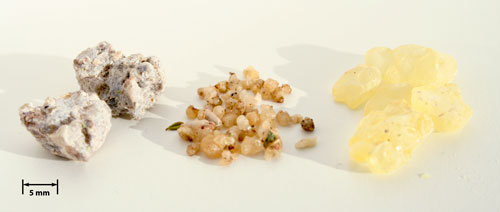
AFTER several weeks of wandering the desert after their escape from Egypt, the Israelites were hungry, the Bible says, and started grumbling.
So God conjured up two things for them to eat. In the evening, there were quails.
“In the morning,” the Book of Exodus says, “there was a layer of dew around the camp. When the layer of dew evaporated, behold, on the surface of the wilderness there was a fine flake-like thing, fine as frost on the ground. When the sons of Israel saw it, they said to one another, ‘What is it?’ ”
In ancient Hebrew, “what is it” can be rendered man-hu, a likely derivation of what this food has come to be called, manna.
Both of them look like what they are: stuff knocked off bushes by the desert gatherers who harvest it. They contain bits of twigs and leaves and who knows what else. The Hedysarum (type of Manna) is $22 an ounce, and the Shir-Khesht is $28.
Ravenous insects puncture holes in the stems, leaves and roots of the plant, causing sap to run. Sometimes the bugs eat the sap and poop it out as sweet honeydew.
Paul Liebrandt of Corton in Manhattan used Shir-Khesht manna in a dish of charred Frog Hollow Farm apricots, fresh wasabi and Kindai kampachi. “The texture is unlike any other I’ve experienced — chewy and crunchy at the same time,” Mr. Liebrandt said. “It also makes the food intensely personal, because no two people taste manna the same way. I might taste a haunting minty-ness, while you might detect a whiff of lemon. No other ingredient is like that.”
Hedysarum manna comes from Hedysarum alhagi, the camel thorn bush. It resembles Grape-Nuts mixed with aquarium sand, and tastes like a combination of maple syrup, brown sugar, blackstrap molasses, honey and nuts.
The Bible describes it as being “like coriander seed,” and “white, and its taste was like wafers with honey.”
But as miraculous as its biblical apparition may seem, manna is real and some chefs have been cooking with it.
The dozens of varieties of what are called mannas have two things in common. They are sweet and, as in the Bible, they appear as if delivered by providence, without cultivation.
Most of this manna is either dried plant sap extruded from tiny holes chewed out by almost invisible bugs, or a honeydew excreted by bugs that eat the sap.
(via NY Times)

No comments:
Post a Comment